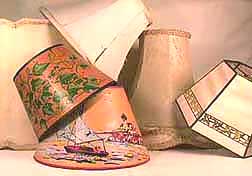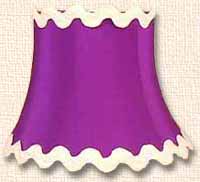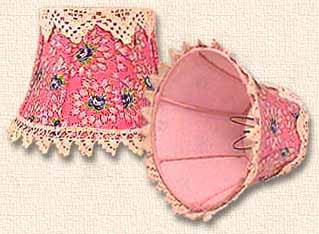|
|
|
Chapter 2
Recycling and Lampshades
What's included . . .
The lampshade shown in the link buttons was my first soft-shade project, and because both the frame and fabric were recycled, it cost me almost nothing. There are lots of stretch-style frames around equally worthy of restoration, and rings can be scavenged from hardbacks. However, those of us who love vintage lampshades ask that you preserve any good examples, until completely beyond use (give it to someone who's into old stuff, if not your thing). And please take a picture for the record (and send me a copy, if you don't mind), before stripping any shade of possible interest, especially those made prior to 1960 (including any trimmings, which can sometimes also be recycled, too). Before and after pictures are also proof that it's a vintage frame, as well as a good sales tool (no matter how old the frame).
This chapter offers lots of information on recycling lampshade frames, frame restoration (including a readily found, easy-to-use, little-known rust remover), application tips for Rust-Oleum products and spray paint, discussion on the use of vintage and recycled fabrics and trims, and much more.
Excerpts from intro to this chapter . . .
|
|
"Not only do I love old lamps, but, it will come as no surprise, that I also dearly love old lampshades. They just don't make 'em like they used to. One hope I have for this book is that it will lead to the replication of vintage lampshades, before there aren't any left to copy from. Unfortunately, the types of materials used to create lampshades aren't particularly sturdy to start with. Couple that with years and years of exposure to light, heat, and dust, and the result is that many swell old shades are just too far gone to be saved."
|
 I still use these three hardback shades, but the stretch shades are ready for restoration. Always take a picture, first, for the record.
I still use these three hardback shades, but the stretch shades are ready for restoration. Always take a picture, first, for the record.
|
|
"Although the cover may not be salvageable, the metal framework beneath it almost always is. Recycling isn't your only source for frames (they can be purchased new, most likely by mail-order), but knowing how to recover them means that all those stashed away lampshades can now be brought back to life. It also means that every wonderful frame you re-dress is one that won't end up lost to the dump."
|
 This little stretch shade was made from one sleeve of a silk blouse that cost fifty cents at a garage sale. It's trimmed with vintage, jumbo rick-rack.
This little stretch shade was made from one sleeve of a silk blouse that cost fifty cents at a garage sale. It's trimmed with vintage, jumbo rick-rack.
|
Other Recycling Ideas
"Because of the small yardage requirements, recycling is a fantastic source for lampshade fabrics, particularly the kind used to make soft shades, such as silk, rayon, chiffon, and lace. Cottons, linens, velvets, and brocades can be used to make Victorian-style (or any shade made by this technique) and hardback shades. You'll also find beaded, sequined, and embroidered fabrics, as well as trims that can be re-used."
"Antique and vintage fabrics and trims (including lace, crocheted, and tatted edgings), can also be put to excellent use with this craft. There are some shade makers who are working strictly with old materials. You can use "new" (never used) yard goods or recycle vintage clothing and other kinds of textiles, such as table linens, bark cloth, lace curtains, hankies, and silk scarves."
|
|
The same little frame, but covered with vintage feedsack fabric, using the panel-shade, hand-sewn method. It's trimmed with old crocheted edgings, which are perfect for this craft, and gleaned from pillowcases, table runners, doilies, plus there's miles of it available via antiques and collectible sources, or, better yet, crochet your own (edgings are quick and quite easy). Both of these shades are illustrations from the book. |

|
|
Sources For Vintage and Used Frames
"The practice of squirreling away damaged lampshades is nothing new, and, as a result, vintage ring and stretch shades are still reasonably abundant. And while hexagons are scarce and real 'Victorians' even scarcer, there are still some around, passed up because of their condition. There are also plenty of used (primarily stretch and ring) shades to be found. Among the places to look for recyclable shades are garage and estate sales, antiques and junk stores, thrift shops, flea markets, and then you may already have a variety of shades stashed away (or possibly still on your lamps) that are beyond use in their current condition."
|
|
|

















